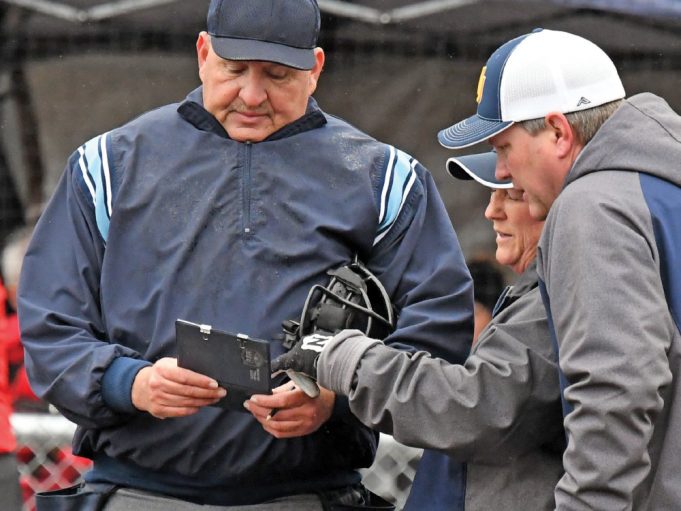“Coach, do you have any changes?” Be honest. How many of you dread asking this question during the pregame conference? We know the most trouble we get into, after misapplication of the rules, is lineup card mismanagement.
So, let’s start this from the very beginning — the pregame meeting. Think of this in sequence. First, you and your partner(s) arrive at home plate and you greet both coaches. Following protocol, you take the home coach’s lineup first, scanning it quickly for duplicate numbers as well as verifying all players are listed at a different position. Before handing it back, you also check that all starters are listed on the roster. You give it back to the coach and ask, “Do you want to check this one more time before I make it official?” While the home coach is double-checking the lineup card, you follow the same procedure for the visiting team, giving its coach a moment to double-check the lineup, too. When both lineups are returned, you declare, “Lineups are now official.”
Now comes the moment many inexperienced umpires dread. The home coach says, “I want to put my FLEX in for my DP and drop to nine.” Basic rule of thumb, this is a substitution. So how do we do this? On the lineup card, we place an “X” in the substitution zone beside the DP’s position. That’s it! The DP has now been substituted for by the FLEX. No mark is necessary next to the FLEX’s position because the FLEX has not left the game.
Working with a lot of novice umpires, this has traditionally been a point of much confusion. By rule, the FLEX can play defense for any player on the field but may only bat or run for the DP. What confuses most new umpires is simply putting the “X” beside the DP. We’re all used to writing in the player’s number who subs for someone, so in the case of the FLEX for the DP it seems foreign.
So why don’t we place the FLEX’s number instead of the “X?” It’s due to the fact that, even though the DP has been substituted for, the FLEX is not a sub. By placing the “X” instead of the number, it reminds us the FLEX has the ability to move in and out of the DP’s position at any time with only the player in the DP position being in jeopardy of removal from the game.
To be clear, when you start the game with a DP and a FLEX, their spots in the lineup will never be eliminated. It’s up to the coach if he or she wants to finish with the FLEX or DP in the game, which is different than the baseball DH rule, which often confuses umpires who work both sports.
After the home coach has announced the change (and you make sure the visiting coach has received the change), the visiting coach now announces, “My DP is going to pitch for the FLEX.” This also brings the lineup down to nine players. We do the same as we did for the DP, but instead of putting the “X” in the DP’s substitution zone, we now place it in the FLEX’s. By rule, anytime the FLEX is not listed as playing defense, this is a substitution against her.
Both of these scenarios provide most teams a way to open up a spot for better defensive or offensive players later in the game. If you start with nine listed on the official lineup, you must finish with nine. If you start with 10, you’re allowed the option of finishing with nine. If only the rule were this simple.
What can and sometimes does happen later in the game, though, could go something like this. A coach states, “My DP is going to pitch for my FLEX, my FLEX will play second base and the second baseman will be my OP (Offensive Player).” This is not one of those wild “what ifs.” Frequently, when a team has only two pitchers it trusts and both are good hitters and fielders, coaches do whatever it takes to keep them in the game.
The first question you have to ask yourself is, “Do I have a sub?” The answer is no. All the coach announced was three defensive changes. By rule, both the DP and the FLEX can play defense at the same time. The FLEX may play defense for any player.
As mentioned earlier, the FLEX can bat or run for the DP but no one else. You mark on the lineup card the DP is now pitching (where the FLEX was originally listed). The FLEX now changes defensive positions and is now playing second base. The second baseman, while not playing defense, stays in the lineup and becomes the OP. She will remain in the same spot in the batting order. All changes in this case will not be marked in the substitution zone of the lineup card, but in the position column. Make sure you notify the scorekeeper and opposing coach of these changes when you’re done.
Take a moment and consider how you would best answer a coach when asked, “The FLEX and DP are interchangeable, right?” Most of you perhaps said to yourself, “No, they aren’t. Wait, yes they are.” If you’re confused, you’re right on both counts. The best way to answer a coach is to state the positions can sub as much as they want, but the players can only enter or re-enter depending on which rulebook you’re using. For NCAA, starters can re-enter once; subs have no re-entry rights. For USA Softball, NFHS and USSSA, starters and subs can re-enter one time each.
The simplest way to manage the DP/FLEX rule, and keep this straight in your head, is this: If the DP is removed from the batting order, she has been subbed for. If the FLEX is not a fielder when on defense, she’s been subbed for. If there is a straight player-for-player substitution for either the DP or the FLEX, this counts against them as well. As with any sub on the roster, when the DP or the FLEX re-enter the game, make sure you circle her number on the lineup card. This reminds you she’s not allowed to be re-entered again.
Maintaining control of your lineup card is one of those unrecognized duties all umpires must master. When we do it right, no one notices or acknowledges how well we do it. When we make an error, it becomes a nightmare to fix. Straight player-for-player substitutions are easy; keeping constant awareness of the DP/FLEX rule is what separates umpires. Take time to practice these scenarios on a lineup card to get familiar with the proper marks.
And in no time, you will master the rule.
What's Your Call? Leave a Comment:
Note: This article is archival in nature. Rules, interpretations, mechanics, philosophies and other information may or may not be correct for the current year.
This article is the copyright of ©Referee Enterprises, Inc., and may not be republished in whole or in part online, in print or in any capacity without expressed written permission from Referee. The article is made available for educational use by individuals.


















